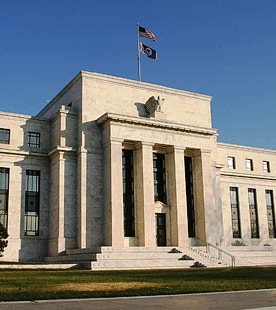
When I went to work for the Fed as an economist in 1964, William McChesney Martin, Jr. was still Chairman, having first been appointed by President Truman. Martin would surely be stunned by the activism of today's Fed -- and the breadth of agreement that it is doing the right thing -- as it drops monetary napalm on dangerously frozen peaks of our financial system.
Martin would surely be stunned by the activism of today's Fed -- and the breadth of agreement that it is doing the right thing -- as it drops monetary napalm on dangerously frozen peaks of our financial system.
My post then was in the Division of International Finance headed by Ralph Young, who edited the third edition of The Federal Reserve System: Purposes and Functions, 1954. (The first edition was drafted by the great Bray Hammond in 1939. By 2005 the book was into its ninth edition.) The marble facade of the Fed at 21st and C Streets is unaltered, but inside at least three important things have changed -- the link to gold, the size of Fed assets and the reach of the Fed into financial markets.
1. Link to gold broken.
Back in 1964, the Treasury bought gold at a fixed price of $35 an ounce from private owners of gold, forbidden 30 years earlier from holding gold for speculative purposes. Purposes and Functions, 3rd edition says (97-99):
Gold is the ultimate basis of Federal Reserve credit and gold movements are an important factor in member bank use of Federal Reserve credit. The power of the Reserve Banks to create money is limited by the requirement of a 25 percent reserve in gold certificates against the total of deposits and issued Federal Reserve notes. All gold that enters the monetary mechanism becomes reserve money of the Federal Reserve Banks in the form of gold certificates. In practice most of their reserves are represented by a credit in a gold certificate account on the books of the Treasury.
The last connection between gold held by the Treasury and Federal Reserve Bank deposits was ended by President Nixon in 1971, under the pressure of the OPEC-led oil shortages. This also ended the gold standard and removed a cornerstone of the Bretton Woods system.
2. Increase in Federal Reserve assets.
Fed assets from 1920 through 1953, shown in Purposes and Functions, 3rd edition, rose from $6 billion to $53 billion.
Fast forward to December 2008. Fed assets were growly slowly toward the $1 trillion mark until the freeze hit starting with the Fannie Mae and Freddie Mac bailout. Fed assets (Reserve Bank credit) more than doubled from a year earlier, to $2.17 trillion as of December 3. The President of the Dallas Federal Reserve Bank opined in early November that Fed assets will reach $3 trillion by the end of 2008.
3. Market Intervention
A "bills only" policy was abandoned in 1961, but a "bills preferably" goal still made sense because open market operations to pursue monetary policy are easiest to manage in the most liquid part of the market, the short end. In recent weeks, however, the Fed's efforts to defrost bank vaults have driven the return on Treasury bills to zero and the Fed has no choice but to operate at longer maturities. It also shows the limit of monetary policy and the reason for the current focus on direct spending.
Former Fed Governor Laurence Meyer, Vice Chairman of Macroeconomic Advisers, is speaking to the New York Association for Business Economics on December 17. The title of his talk is: "Monetary Policy: Whatever It Takes." He was widely quoted on November 27 as saying that monetary authorities are prepared to do "whatever it takes" to get past the current credit lockup. However, he went on to say: "The problem is, the more you go in this direction, the harder it is to turn around and the harder your exit strategy is." .